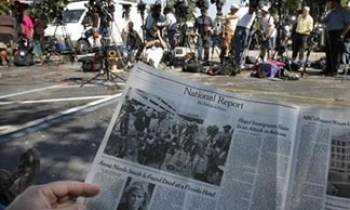The success of any investigative story or series rides or falls on how early the editor becomes a collaborator in the process. By editor, I mean the lucky soul who will be doing the manuscript editing at the tail end of the process. There are four points at which he or she can become involved:
1. At the initiation of the story itself;
2. During the reporting;
3. After the reporting but before the writing;
4. And, finally, of course, in the actual line editing or, if necessary, restructuring of the manuscript.
Involving your editor in all the stages, one through four, will save a world of grief for both editor and reporter. (Among other benefits of proximity, the reporter may even drop his paranoia enough to think of the editor as a partner!) Involving your editor in stages two through four is next best. Even involving the editor just in stages three and four often works.
But involving the editor -- or, if you're the big boss, calling in the cavalry -- only in stage four? That's a sure-fire recipe for disaster. The magnitude of the disaster can be measured by the frequency of the following utterances: "Whose goofball idea was this in the first place?" (referring back to stage one). "The reporting has more holes in it than a presidential position paper" (referring back to stage two). "If I had known this is what you had, I would have suggested we approach it this way . . ." (referring back to stage three). Or all of the above.
Far too often for me, over the course of twenty-six years as an editor at newspapers and five as an editor at magazines, it has been all of the above. And I like to think that this experience has taught me something. What it has taught me is that if I can have only one of the four stages, I will take stage three -- the sit-down between editor and reporter, after the reporting but before the writing.
That, my friends, is where the rubber meets the road. It is where the editor finds out if the reporter has the faintest clue how to climb the mountain of documentation and notes he has assembled and emerge at the top with a sharply-worded, crisp, briskly told tale. Often, even the best reporters and most facile writers need help at this stage, and it is no wonder. After all those interviews, after weeks or months of document-digging, trail-sniffing, blind alleys, discoveries, dry holes, and amazing finds, synthesizing all that material is a daunting task.
What I like to give the reporters in this post-reporting, pre-writing session is what I call the twenty-five-words-or-less test. This is not my idea. (Few of my more effective practices are; I'll steal from anyone.) As far as I can trace, it originated with David Belasco, the former Broadway producer. Belasco spent much of his working day receiving supplicants: would-be playwrights who wanted him to produce their script, or their idea for a script. And whether the work in question was a one-act play with a single character, or a four-act play with twenty-six characters and seventeen subplots, Belasco would tell these supplicants, "If you can't write your idea on the back of my calling card, you don't have a clear idea." So I stole that, and I tell the reporter sitting in my office, "Look, I know you spent nine months and $XXX,000 of the newspaper's money chasing this thing to ground. But I want you to sum it all up for me in twenty-five words or less. Take your time. Go walk around the block, or go out for a drink, or whatever, if you want. But then come back and give it to me in twenty-five words or less. And you're not allowed twenty-six."
Believe it or not, this works. You, the investigative reporter, may well think your project is far too complex, far too nuanced, far too important to be reduced to a twenty-five-word nut. I can only tell you this: in the course of editing eleven Pulitzer Prize-winning stories or series and, in the magazine realm, a National Magazine Award winner and three finalists, I have yet to run across the story too complex or too nuanced or too important to be summed up in twenty-five words or less. And once the reporter-writer submits himself to that discipline -- thinks it through and comes up with the twenty-five words -- a magical thing can happen.
Three things, actually. Presto, the heart of the story -- the incisively stated, powerful topic paragraph -- has been essentially written. And, in all likelihood, a blueprint has been revealed for how to go about constructing the entire story or series. And -- just as important -- it will quickly become clear if there are holes in that mountain of assembled data on which you are both staking your careers.
You can't ask for much more than that.
In most investigative projects, alas, none of this happens. And that's too bad. For I believe that the reason many a worthy project in the end leaves few ripples in the pond into which the stone was thrown is not that it was poorly reported, not that it failed to deliver the goods, not that the idea was flawed; but, rather, that weeks and months of superb reporting were tossed down the drain by tedious writing and uninspired editing.
And that, in turn, is not just a failure to execute stage four well but almost certainly a breakdown in the process at stage three. For two years, I served as a Pulitzer judge, sorting through 200 to 250 entries in a given category. These stories were so important to the newspaper that published them that it had nominated them for the ultimate accolade. Yet I cannot tell you how many times my fellow judges and I would throw up our hands in exasperation and ask, "Can you figure out what they're driving at?" That is a terrible waste -- of the reporter's effort, of the newspaper's money and newshole, and of the editor's ulcer. Gene Roberts, my boss and mentor for seventeen years at The Philadelphia Inquirer, used to put it this way: "Nobody ever won a Pulitzer Prize because of the first twenty or thirty column-inches of a major story. But hundreds have lost a Pulitzer because of those first twenty or thirty inches." I have no doubt he is correct.
I also have no doubt that if your story befuddles those judges, it also almost certainly befuddled your readers. And that's the real crime.
I want to touch on one other thought, and that is what happens to the story once a polished, agonized-over, and carefully crafted manuscript is delivered. The editor of that story, or series, fully as much as the reporter -- no, more than the reporter -- then has the task of carrying the baby safely through a woods full of dangers.
That woods is . . . your own organization. There are so many ways to trip up a great story -- from layout and makeup that does not give the story the pride of place that the effort deserves, to timid copy-editing and lawyering that eventually blankets the story like a new snowfall blurring a rocky landscape.
At this point you are no longer the coach; you are the blocking back. The reporter is the ball carrier and the story is the football. To mix a metaphor, this is where you, the editor, have to, without declaring so -- God, never declare so -- become a guerrilla warrior protecting the project from all the inevitable internal forces that serve to blunt its impact.
Frankly, over the years, in the always-perilous process of getting an investigative story or series ready for print and, finally, into print, I have had to make more shoestring catches to save a story from well-intentioned but ultimately wrongheaded editors -- both above and below me -- than from reporters themselves. But that, my friends, is another story.
Steve Lovelady worked at The Philadelphia Inquirer for twenty-two years, the final five as managing editor, and has worked at Time Inc. as an editor-at-large for the past five years.









